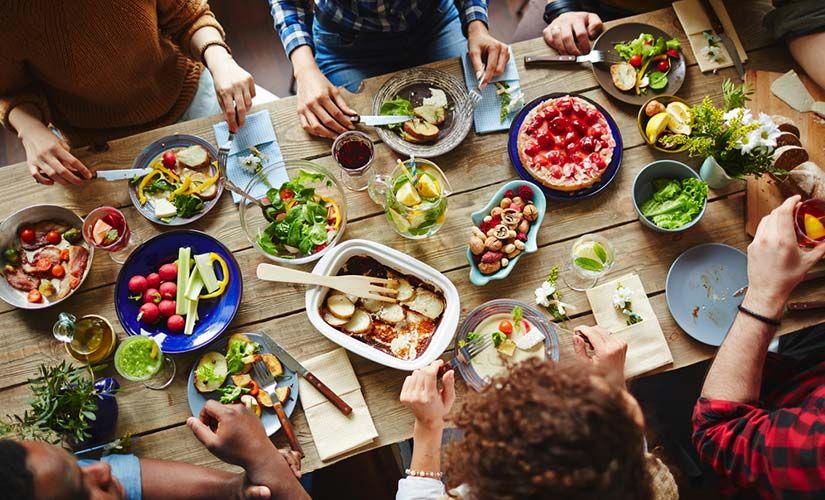The Christian liturgical year is built around feast days, seasons of fasting, and the ordinary time in between. How do we faithfully structure our eating rhythms, and how might they lead us deeper into Scripture? In this three-part series, writer Annelise Jolley explores the connection between physical and spiritual disciplines and how God's Word can nourish, galvanize, and lead us into a hospitable life.
My memory is full of feasts. My favorite and most vivid recollections contain flavors and smells, faces turned warm by candles, ingredients and those who prepared them, and how it felt to eat good food in good company. These meals often carry special weight because of what they represent—a birthday, a visit to a new country, a homecoming.
Biblical Feast Days
Israelites (and today’s observant Jews) followed a rhythm of life marked by feasts and fasts. In the Old Testament God lays out times for his people to abstain from food, as well as times to indulge. There is the Feast of Harvest, Feast of Ingathering, and the Feast of Unleavened Bread to name a few. Today, the Christian liturgical calendar (which follows the biblical narrative) also marks feast days (such as Epiphany), times of fasting (such as Lent), and the ordinary time in between.
Like rituals marked “holy,” feasts are set apart. By naming feast days, the implication is that other days are for normal, tempered eating (or for fasting from food altogether). The structure of feasting and fasting set out in the liturgical calendar is a gift: it teaches us a rhythm to live by. True feasting, an occasional and set apart event, is different than near-constant indulgence—in fact, it protects us from making indulgence the norm rather than a celebration. When I overindulge, I become saturated and unresponsive to the delight of a real feast; I can practice true feasting only when I also practice fasting and ordinary meals.
Why God Invites Us to Feast
The biblical call to feast is a nudge from God to remember joy. It is a command toward celebration and a literal foretaste of the great feast to come. In the book of Revelation, John records his vision of the Marriage Supper of the Lamb. The feasts of the Old Testament, the wedding of Cana, and the meals we share together today are echoes of this ultimate banquet, when God will gather people from every nation around his table to eat together.
Feasting is a physical reminder of God’s abundance. When discontentment or fear flares up in our lives, feasting offers a buoy—a reminder that there is more than enough in God to go around. Feasting is God’s lavishness presented through food. Flavors and textures and color didn’t need to exist, but they do. Food didn’t need to do anything more than keep us alive, but it does. When we enjoy a good meal, we ingest a material taste of God’s abundance.
In feasting we are invited to practice the ways of Jesus. We are invited to extend outrageous hospitality and generosity, inviting the stranger and friend alike, giving everyone a taste of the kingdom. “When you give a feast, invite the poor, the crippled, the lame, the blind, and you will be blessed, because they cannot repay you. For you will be repaid at the resurrection of the just” (Luke 14:13-14). Feasting reminds us of the marriage supper to come, and to act like a new order is not just possible but inevitable.
Feasting on God’s Word
In one of Jesus’s “I am” statements, he tells his hungry listeners, I am the bread of life. He has just multiplied a meal of fish and bread to care for people’s physical needs. The now-satisfied crowd follows him to Capernaum, apparently hoping for another miraculous feast. When they arrive, Jesus reprimands them. “Do not work for the food that perishes,” he tells them, “but for the food that endures to eternal life, which the Son of Man will give to you.” He then tells them where to find this bread: “I am the bread of life; whoever comes to me shall not hunger, and whoever believes in me shall never thirst” (John 6:27, 35).
What Jesus is offering here is himself, for the nourishment of body and spirit. One way we receive this nourishment is by feasting on God’s Word.
While feasting in the company of friends and family satisfies our hunger for community, food, laughter, and beauty, feasting on God’s Word allows our deepest hunger to be continually filled. Drawing near to God through Scripture satisfies our ache for intimacy and union with the God who made us, who also made taste buds and ears to hear the sound of garlic jumping in olive oil and noses to inhale the scent of a just-ripe peach.
What does it look like to feast on God’s Word? I think of the steps involved in throwing and participating in a great party: the invitations, the preparation of food and table, the arrival of guests, and the satisfaction of eating together. After a feast, the food we have eaten nourishes our bodies as the conversation nourishes our spirit.
The steps required for feasting can be applied to Bible reading
First, the invitation. A feast can’t take place without people. As we open the Bible, we can invite ourselves to sit up and take notice of God’s already-with-us presence. We can invite the Spirit to soften and prepare our hearts.
Next, the preparation. A feast requires mincing, glazing, grilling; there are drinks to be poured, food to be plated, tables to be set. Meeting God in Scripture also requires preparation. One of my favorite ways to prepare to read the Bible is by sitting for several minutes in silence. A short time of wordless contemplation stills my mind and readies me to ingest Scripture.
Next, the act of eating. Here I think of Lectio Divina—Latin for “divine reading”—and its second step, meditation. This step invites the reader to mull over a specific phrase or a verse, turning it over in one’s mouth and mind. The reader chews on it, tests it from different angles and vantage points, considering the details and textures of the words, just as a guest appreciates the flavors and nuances of the host’s meal.
Finally, we ingest Scripture through prayer and contemplation. At the best celebrations, people linger around the table long after the food is gone. They bask in each other’s company, digest the meal, maybe pour more wine. By resting in God’s presence after reading his Word, we allow the Word to take up space in our body. When we leave the table, we carry this spiritual food with us.
Scripture promises that God will prepare “a feast of rich food for all peoples, a banquet of aged wine—the best of meats and the finest of wines” (Isaiah 25:6). At this table there will be no more tears, because God will have “swallowed up death forever.” In each bite we take today, whether of food or of Scripture, we anticipate the fulfillment of this passage and the wedding feast to come.
Read more posts about: Getting Started, Community Practices, Physical and Spiritual Disciplines
Thanks to the support of our faithful financial partners, American Bible Society has been engaging people with the life-changing message of God’s Word for more than 200 years.
Help us share God's Word where
needed most.
Sign up to receive Bible-reading tips, tools and resources.




